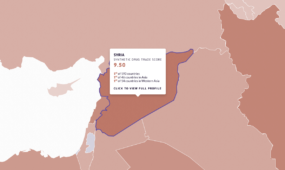Posted on 13 Oct 2023
Western Asia is perceived as playing a relatively minor role in the global cocaine trade. However, claims that Turkey may be emerging as a major cocaine corridor to Europe raise questions about a potential influx of the drug into the rest of Western Asia. Although there is little reason to expect cocaine to flood the streets any time soon, a closer look at the region’s indirect links to the cocaine market reveals the drug’s growing role.
Western Asia has long been a hotbed for various illicit drugs, including hashish, methamphetamine and Captagon. Cocaine, by contrast, has not gained a foothold in the region, despite continued increases in supply and demand worldwide. However, in recent years, there have been signs that Turkey may be becoming the next key cocaine transit hub. The amount of cocaine seized in the country rose from 393 kilograms in 2014 to nearly three tonnes in 2021, according to the United Nations Office on Drugs and Crime (UNODC). Although Turkish officials reported a 44 per cent increase in cocaine seizures between 2021 and 2022, data on domestic consumption did not show a parallel increase, suggesting that the country is likely to serve as a drug corridor.
The re-election in May 2023 of President Erdogan, whose political circle has been reportedly marred by corruption cases and scandals linked to the cocaine trade, suggests that the country’s suspected role as a cocaine corridor is unlikely to diminish any time soon.
Turkish criminal networks – already key players in the heroin trade – appear to have found new ways to exploit the country’s minimal resilience to organized crime, working with Latin American and Balkan groups to keep up with the escalating global demand for cocaine. The lion’s share of cocaine in Turkey (shipped directly from Latin America or via West Africa) is thought to be smuggled onwards to consumers in Eastern Europe and the Caucasus.
At first glance, Turkey’s apparent emergence as a cocaine hub could pave the way for the drug’s expansion throughout the rest of Western Asia. Such a development has already occurred in North Africa, where reports of cocaine seizures have increased as West Africa’s role as a transit point on the cocaine supply routes has grown. In Western Asia, the infrastructure needed for cocaine to spread is already in place. Turkish criminal groups are involved in many of the region’s illicit flows, including heroin, arms and antiquities – setting the stage for cocaine to follow suit. However, it remains to be seen whether the drug will flood the regional market.
Costs and competition
Of the factors that most limit the potential for cocaine to gain traction in the region, perhaps the most critical is the drug’s high price tag. Although global cocaine prices have plummeted in recent decades, the difficulty for Latin American suppliers to access Western Asia’s markets has led to a perpetual cycle of extraordinarily high prices. In Oman, for example, prices range from US$130 to US$260 per gram, while in Israel they reach US$203. By contrast, the average price per gram in Western and central Europe is around US$84.
Although a cocaine depot in nearby Turkey may have the effect of exerting downward pressure on these prices, cocaine will still be out of the price range for the majority of the region’s drug users. This is especially true given that there is no shortage of alternatives. Heroin, for example, one of the most widely used drugs in the region, can be bought in Iran for less than US$2 a gram.
Captagon, in particular, has become cocaine’s main competitor in Western Asia. Produced mainly in Syria, and to a lesser extent in Lebanon, this highly addictive amphetamine not only costs less than US$0.50 per tablet in some parts of the Levant, but also produces similar effects to cocaine, including the ability to suppress fatigue and appetite.
Too many stakeholders
For cocaine suppliers from Latin America and Turkey to establish a significant presence in Western Asia, they would need, at a minimum, to align themselves with established drug traffickers in the region. This has been the case in Turkey, where Latin American groups capitalized on their expertise, resources and networks to establish a cocaine corridor stretching from Turkey to Europe, the Caucasus and Russia. This operation involved close collaboration with Turkish heroin traffickers and Balkan criminals, allowing them to leverage existing networks and knowledge from the long-standing heroin trade.
It remains to be seen, however, whether cocaine suppliers can exploit such connections to reach the broader Western Asia region. Those who control the region’s drug economies may have little incentive to diversify the market that they currently monopolize – especially as there are no gaps to fill. The region is awash with militias, terrorist groups and other criminal actors – including Lebanon’s Hezbollah and Iranian militias, local warlords and even the Syrian regime – that have a vested interest in maintaining their monopoly, particularly as growing instability in the region presents opportunities to exploit. Volatility in the region may well drive a quick need for cash, with the funding of conflict through drug trafficking becoming a vulnerability.
Within Western Asia’s criminal landscape, Iranian actors may be the most inclined to join forces with Latin American cocaine suppliers, including Mexican cartels, although their appetite for the cocaine trade may have diminished in light of the region’s escalating meth market.
Opportunities in the Gulf?
Although cocaine may not be the preferred illicit substance among drug users in the region, there are some notable exceptions. In the Gulf states, as well as other hotspots in Lebanon and Israel, there are some vibrant consumer markets. In Saudi Arabia and the United Arab Emirates (UAE), cocaine has become the drug of choice among some local and expatriate communities.
Skyrocketing prices are not a deterrent for Saudi Arabia’s wealthy population – the world’s most expensive cocaine is reportedly sold in the oil-rich kingdom for US$533 per gram – but rather add to its appeal as a luxury item and status symbol. In the Levant, cocaine use has reportedly increased among the growing middle and upper classes, and particularly young people.
It is in these niche wealthy markets that the impact of a Turkish cocaine corridor would probably be most felt. However, UNODC findings do not reflect this, suggesting instead that smuggling activities appear to involve mainly foreign nationals with no apparent connection to Turkey catering to foreign individuals and expatriate communities. Similarly, seizures of cocaine being shipped from Turkey to Western Asia in 2023 have so far been remarkably low. Nevertheless, the Gulf remains the most likely candidate for an expanded cocaine market.
A wider perspective
Although cocaine use within Western Asia is likely to remain relatively low level compared with other drugs in the region, a closer examination of the region’s global role in the cocaine trade reveals its growing influence.
The involvement of Lebanon’s Hezbollah, for example, in the cocaine trade extends beyond their home territory, as they seek to expand influence and operations globally. In West Africa, high-ranking members of the group have been implicated in the cocaine trade between Latin America and Europe. Collaborating with members of the diaspora and local criminal groups in countries such as Côte d’Ivoire and Senegal, Hezbollah has been found to launder the illicit proceeds back in Lebanon, highlighting the wider implications of the expanding reach of Western Asia’s criminal actors.
Western Asia not only exports cocaine criminals, but also appears to afford them some protection. Gulf states have become safe havens for some of the world’s most notorious cocaine criminals, including members of the Dutch Mocro Mafia, leaders of the Irish Kinahan cartel and Balkan criminals. These individuals escape prosecution in their home countries and find opportunity for freedom in Gulf states.
As the Gulf experiences an influx of cocaine expats, it is also witnessing the inflow of illicit proceeds from the drug trade. Dubiously sourced wealth entering the region from abroad has drawn significant scrutiny from the international community, resulting in the UAE being placed on the Financial Action Task Force’s ‘grey money list’ in 2022. The real-estate boom in Dubai in recent years has been linked to the influx of illicit funds derived from the drug trade and other illicit activities.
Even if Turkey were to further establish itself as a major cocaine corridor, it is unlikely that this would lead to an immediate surge of the drug in Western Asia. However, in the current context of instability and the drive for resources that come with it, this development may set the stage for the drug trade to introduce new dynamics and challenges to the region. As Western Asia finds its position in the global cocaine market, it is critical to understand its role as a haven for the world’s cocaine kingpins and the involvement of its criminal groups abroad.
This analysis is part of the GI-TOC’s series of articles unpacking the role of drugs in organized crime in Western Asia. The series explores, from a regional perspective, how drug trafficking is influenced by instability and broader geopolitics, the effects it has on local dynamics throughout illicit supply chains and its wider global impact. Sign up to our Western Asia mailing list.



